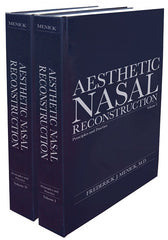About the Book
Aesthetic Nasal Reconstruction Principles and Practice
Frederick J. Menick, M.D.
Aesthetic Nasal Reconstruction Principles and Practice is the latest two-volume textbook from Frederick J. Menick, M.D., the world's leading authority on nasal reconstruction.
The most comprehensive nasal reconstruction book ever published, Aesthetic Nasal Reconstruction Principles and Practice includes hundreds of cases — from simple to complex and small to large defects — plus 6,500+ step-by-step pre-, intra-, and post-op images.

Success in aesthetic nasal reconstruction is earned through careful planning and deliberate choices. It is as much about what you don't do as what you do.
Planning is paramount, and the best plans are derived from understanding and practicing the tried-and-true principles explained in Aesthetic Nasal Reconstruction Principles and Practice.
In this two-volume set, Dr. Frederick Menick shares his pioneering techniques and invaluable lessons from his 35-year clinical practice.
Based on a principled approach to repair, you’ll learn how to:
- Know the Normal
- Analyze a defect and formulate a solid approach to reconstruction, based on fundamental principles
- Define the "true" tissue loss to determine what is missing and what is present, plus evaluate what tissues are available and appropriate to make what you want
- Set priorities and develop a plan
- Prepare the wound, patient, and surgeon for success
- Design operative templates to replace tissues accurately
- Replace missing cover, lining, and support
- Employ secondary healing
- Use forehead skin grafts for nasal resurfacing
- Decide when and how to use local flaps
- Choose between nasolabial and forehead donors
- Use a 2- and 3-stage forehead flap (indications and techniques)
- Handle the forehead donor site — primary closure, expansion, surgical delay, harvesting a second or third or fourth flap
- Design and position cartilage support
- Correct initial errors and imperfections before pedicle division
- Avoid and treat complications, such as intraoperative problems, postoperative cover and lining necrosis, and infection
- Revise an imperfect result or re-do a failed reconstruction
- Use microvascular free flaps for nasal reconstruction
- Restore a normal appearance with minimal scarring
Table of Cases
A photographic Table of Cases provides a quick reference to the book's contents. Hundreds of defects — covering the full scope of nasal reconstruction with variability in size, site, outline, depth, and adjacent midface injury — are photographically illustrated within the Table of Cases.
Simply identify a defect similar to the case before you — whether due to trauma, cancer excision, immune disease, infection, a prior failed reconstruction, etc. — and be directed to the solution within the text.
Table of Contents
The Table of Contents directs the reader to comprehensive chapters, which discuss the aesthetic replacement of missing cover, lining, and support — applicable to small and large, simple and complex deformities.
The history, indications and contraindications, technical details, and results are described for hundreds of cases, alongside 6,500+ photographs.
Because problems inevitably arise, specific chapters discuss how to deal with complications, perform a revision of an imperfect repair, or redo a failed repair with another regional flap.
| Chapter 1 | Purpose: What Is a Nose and Why Do We Reconstruct It? |
| Chapter 2 | Principles of Aesthetic Facial and Nasal Repair: Old vs. New |
| Chapter 3 | Preoperative and Operative Planning |
| Chapter 4 | Planning for Skin Cancer Repair |
| Chapter 5 | Planning for Composite Defects That Extend Into the Lip and Cheek |
| Chapter 6 | A Case Study — Principles and Planning |
| Chapter 7 | Introduction to Restoring Skin Cover |
| Chapter 8 | Repairing Small, Superficial Defects |
| Chapter 9 | Repairing Large, Deep Defects |
| Chapter 10 | The Nasolabial Flaps |
| Chapter 11 | 2- and 3-Stage Forehead Flaps |
| Chapter 12 | The Paramedian Forehead Flap — Technical Details |
| Chapter 13 | Case Studies in Forehead Flap Reconstruction |
| Chapter 14 | Managing the Forehead Donor — Primary Closure, Expansion, Delay, Multiple Harvests |
| Chapter 15 | Introduction to Restoring Lining |
| Chapter 16 | Advancement of Residual Nasal Lining |
| Chapter 17 | Composite Skin Grafts |
| Chapter 18 | Prelaminated Lining |
| Chapter 19 | Hingeover Lining |
| Chapter 20 | Using Two Flaps to Line and Cover the Nose |
| Chapter 21 | Intranasal Lining Flaps |
| Chapter 22 | Folding a Full-Thickness Forehead Flap for Lining |
| Chapter 23 | Case Studies — Folded Forehead Flap for Lining |
| Chapter 24 | Skin Grafts for Lining |
| Chapter 25 | Microvascular Flaps for Lining |
| Chapter 26 | Restoring Hard and Soft Tissue Support |
| Chapter 27 | Primary Intranasal Lining Loss — Trauma, Immune Disease, Cocaine Injury |
| Chapter 28 | Columellar Reconstruction |
| Chapter 29 | Dealing With Complications |
| Chapter 30 | Revising an Imperfect Nasal Reconstruction |
| Chapter 31 | A Case Study in Late Revision |
| Chapter 32 | Redoing a Failed Nasal Reconstruction |
| Chapter 33 | Achieving Precision and Patience |

